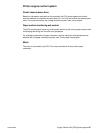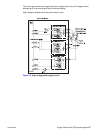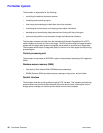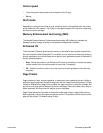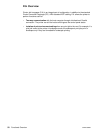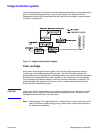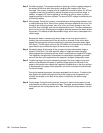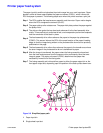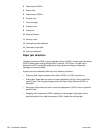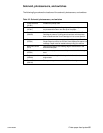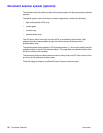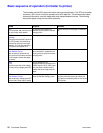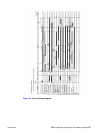
52 Functional Overview
C4224-90962
Step 2 Conditioning stage. This process consists of applying a uniform negative charge to
the surface of the drum with the primary charging roller located in the Toner
Cartridge. The primary charging roller is coated with conductive rubber. An AC bias
is applied to the roller to erase any residual charges from any previous image. In
addition, a negative DC bias is applied by the charging roller to create a uniform
negative potential on the drum surface. The amount of DC voltage is modified by the
print density setting.
Step 3 Writing stage. During this process, a modulated laser diode projects the beam onto
a rotating scanning mirror. As the mirror rotates, the beam reflects off the mirror, first
through a set of focusing lenses, then off a mirror, and finally through a slot in the
top of the Toner Cartridge, and onto the photosensitive drum. The beam sweeps the
drum from left to right, discharging the negative potential wherever the beam strikes
the surface. This creates a latent electrostatic image, which later is developed into a
visible image.
Because the beam is sweeping the entire length of the drum and the drum is
rotating, the entire surface area of the drum can be covered. At the end of each
sweep, the beam strikes the beam detect lens, generating the beam detect signal
(BD signal). The BD signal is sent to the ECU where it is converted to an electrical
signal used to synchronize the output of the next scan line of data.
Step 4 Developing stage. At this stage of the process, the latent electrostatic image is
present on the drum. The toner particles obtain a negative surface charge by
rubbing against the developing cylinder which is connected to a negative DC supply.
The negatively charged toner is attracted to the discharged (exposed, grounded)
areas of the drum, and repelled from the negatively charged (unexposed) areas.
Step 5 Transferring stage. During the transferring process, the toner image on the drum
surface is transferred to the paper. A positive charge applied to the back of the
paper by the transfer roller causes the negatively charged toner on the drum surface
to be attracted to the paper. After separation, the drum is cleaned and conditioned
for the next image.
During the separating process, the paper separates from the drum. To stabilize the
feed system and prevent dropouts on the printed image at low temperature and
humidity, the charge on the back of the paper is reduced by the static charge
eliminator.
Step 6 Fusing stage. During the fusing process, the toner is fused into the paper by heat
and pressure to produce a permanent image. The paper passes between a heated
fusing element and a soft pressure roller. This melts the toner and presses it into the
paper.




